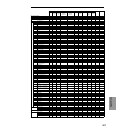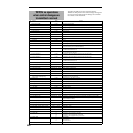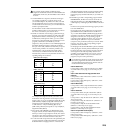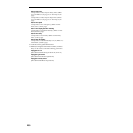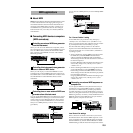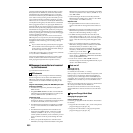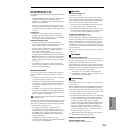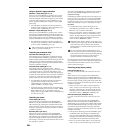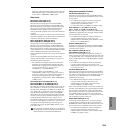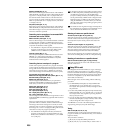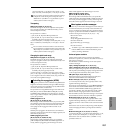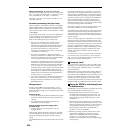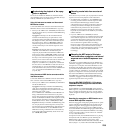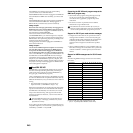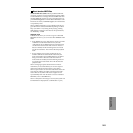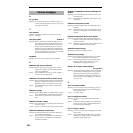
235
Appendices
beginning of the measure in Sequencer mode, Post Insert
Effect Panpot message will be transmitted by each track
whose “Status” is BTH, EXT, or EX2 (☞p.84).
Effect control
Effect control 1 (CC#12) [Bn, 0C, vv]
Effect control 2 (CC#13) [Bn, 0D, vv]
When the above CC# is assigned to the ASSIGNABLE
PEDAL or as the B-mode function of a REALTIME CON-
TROLS knob [1]–[4], operating that controller will transmit
Effect Control 1/2 messages, and the specified dynamic
modulation will be controlled. When this message is
received, the result will be the same as when the controller is
operated.
Although various types of control change can be selected as
dynamic modulation sources, Effect Control 1 (CC#12) and 2
(CC#13) are dedicated for dynamic modulation.
Effect 1 depth (Send 2) (CC#91) [Bn, 5B, vv]
Effect 3 depth (Send 1) (CC#93) [Bn, 5D, vv]
When the above CC# is assigned to the ASSIGNABLE
PEDAL or as the B-mode function of a REALTIME CON-
TROL knob [1]–[4], operating that controller will transmit
Effect 1 Depth (Send 2) or Effect 3 Depth (Send 1) messages,
and the send level 1 or 2 to the master effects MFX1 or MFX2
will be controlled respectively. When this message is
received, the result will be the same as when the controller is
operated.
On the corresponding MIDI channels, this will simulta-
neously control the timbre/track setting as well as the set-
ting following the insertion effect.
• In Combination and Sequencer, the actual send level of
the timbre/track is determined by summing this value
with the send 1/2 settings for each oscillator (PROG 7.1–
1a). (☞p.26 “OSC Send 1/2,” ☞p.46, p.84 “S1
(Send1(MFX1)),” “S2 (Send2(MFX2))”)
•When you adjust “S1 (Send1(MFX1))” or “S2
(Send2(MFX2))” (SEQ 7.1–1(2)a) in Sequencer mode, or
when you re-select a song or return to the beginning of
the measure in Sequencer mode, Send 1/2 will be
transmitted by each track whose “Status” is BTH, EXT,
or EX2. (☞p.84).
Effect 2 depth (IFX on/off) (CC#92) [Bn, 5C, vv]
Effect 4 depth (MFX1 on/off) (CC#94) [Bn, 5E, vv]
Effect 5 depth (MFX2 on/off) (CC#95) [Bn, 5F, vv]
Separately from the effect on/off settings in each mode, “FX
SW” (GLOBAL 1.1–1b) allows you to turn off insert effect
IFX and master effects MFX1 and MFX2. If you check “IFX
Off,” “MFX1 Off” or “MFX2 Off,” the corresponding mes-
sage will be transmitted with vv=0 [00]. If you uncheck
these settings, the corresponding message will be transmit-
ted with vv=127 [7F]. If you check these settings, the corre-
sponding effect(s) will be turned off as a group. If you
uncheck these settings, the on/off settings of each mode will
be used. The same applies to reception. (vv of 00 is off, and
01 or greater is the original setting.) These messages are
transmitted/received on the global MIDI channel. (☞p.27,
p.28 “FX On/Off”)
These messages are defined simply for use in adjusting
the effect levels, and may not have the same function on
another instrument connected to the TRITON Le.
Using various controllers for control
Foot controller (CC#04) [Bn, 04, vv]
If the above CC# is assigned as the ASSIGNABLE PEDAL
function, this message will be transmitted when the control-
ler is operated.
• In Combination and Sequencer modes, transmission/
reception of this message can be turned on/off
independently for each timbre/track.
☞“Foot Pedal/Switch” (COMBI 4.4–2a, SEQ 4.4–3(4)a)
Knob modulation 1, 2, 3, 4 (CC#17, 19, 20, 21)
[Bn, 11, vv], [Bn, 13, vv], [Bn, 14, vv], [Bn, 15, vv]
If the above CC# are assigned to the B-mode of REALTIME
CONTROLS [1]–[4] knobs, these messages will be transmit-
ted when the knobs are operated.
• In Combination and Sequencer modes, transmission/
reception of this message can be turned on/off
independently for each timbre/track (“Realtime Control
Knob1, 2, 3, 4” COMBI/SEQ 4.3).
Controller (CC#83) [Bn, 53, vv]
If the above CC# is assigned to the B-mode of REALTIME
CONTROLS [1]–[4] knobs, this message will be transmitted
when the knob is operated.
SW1 modulation (CC#80) [Bn, 50, vv]
SW2 modulation (CC#81) [Bn, 51, vv]
If the above CC# are assigned as the function of [SW1] or
[SW2], operating the switch will transmit this message with
vv=127 [7F] for ON, and vv=00 [00] for OFF. (These can also
be set as the B-mode functions of the REALTIME CONTROL
knobs [1]–[4].)
• In Combination and Sequencer modes, transmission/
reception of these messages can be turned on/off
independently for each timbre/track (“SW1/2” COMBI
4.4–1a, SEQ 4.4–1/2a)
Foot switch (CC#82) [Bn, 52, vv]
If the above CC# is assigned as the function of the ASSIGN-
ABLE SWITCH, operating the switch will transmit this mes-
sage with vv=127 [7F] for ON, and vv=00 [00] for OFF. (This
can also be set as a B-mode function of the REALTIME
CONTROL knobs [1]–[4].)
• In Combination and Sequencer modes, transmission/
reception of this message can be turned on/off
independently for each timbre/track (“Foot Pedal/
Switch” COMBI 4.4–2a, SEQ 4.4–3(4)a).
When “Foot controller (CC#04)”–”Foot switch (CC#82)” are
operated on the TRITON Le, the specified alternate modula-
tion or dynamic modulation etc. will be controlled. When
these messages are received, the result will be the same as if
the controller had been operated. For “SW1 modulation
(CC#80)”–”Foot switch (CC#82),” vv of 63 [3F] or less will be
OFF, and 64 [40] or greater will be ON.
Damper pedal (CC#64) [Bn, 40, vv]
This message is transmitted when you operate a damper
pedal (separately sold Korg DS-1H etc.) connected to the
DAMPER jack, and the damper effect will be turned on/off.
If the DS-1H is used, a half-damper effect can be applied.
• In Combination and Sequencer modes, transmission/
reception of this message can be turned on/off
independently for each timbre/track (“Damper CC#64”
COMBI 4.1–2a, SEQ 4.1–3(4)a).



